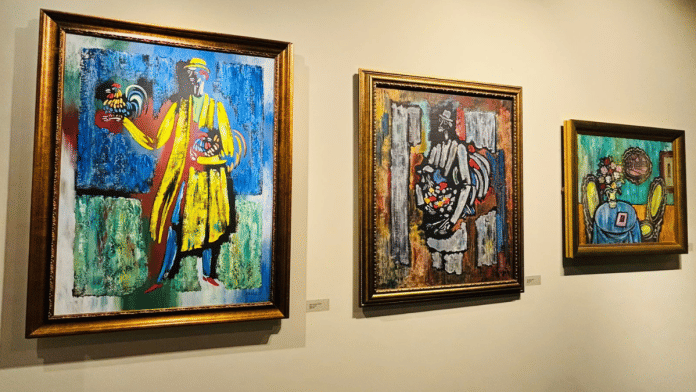Delhi: A Vasant Vihar art gallery became a microcosm of European art on a recent October weekend, showcasing the cultural links between Lithuania, France, and oddly, Delhi — all because of the Lithuanian ambassador to India Diana Mickevičienė.
Mickevičienė often jokes that she’s the only diplomat who’s graduated from Munirka to Vasant Vihar: A former student at JNU, she’s a career diplomat who returned to India as ambassador in 2023. And on 19 October, she shared a part of her own heritage with Vasant Vihar.
The Lithuanian Embassy is displaying works by the artist Vytautas Kasiulis at the Surrendra Paul Art Gallery at Vasant Vihar’s Sangeet Shyamala to celebrate how culture connects the world.
Kasiulis is one of Lithuania’s most famous artists. Though born and raised in Lithuania, he emigrated to Paris to escape Soviet occupation during World War 2 — this is where both his art and his career were shaped. He became part of the School of Paris along with other significant emigres who worked in the city during the 20th century.
“This is a story of an unwilling emigre, homecoming, global appeal, and Parisian charm,” said Mickevičienė at the exhibition opening. “An even more symbolic thing is that the Lithuanian National Museum of Art generously loans these pictures to embassies, who then take Kasiulis out to the broader world and bring his joy to various art lovers across the world.”
The opening of the exhibition was attended by the ambassadors of Ukraine and Czech Republic, former BJP Minister of State for External Affairs and Culture Meenakshi Lekhi, and director of Alliance Francais Patricia Loison, among other expatriates.
“It’s such a delight to have Diana come and look at the space and want to show the famous Lithuanian artist,” said director of Sangeet Shyamala, Vasundhara Tewari Broota. “We are absolutely delighted to have these paintings here with their French charm and beauty!”
A personal story
Exhibiting Kasiulis’ work is “a little bit of a personal journey” for Mickevičienė. It brings together three important cultural identities for her: Lithuanian, French, and Indian.
Kasiulis, who died in 1995, is important to Lithuanians — he became an emblem of what the country lost to the Soviet Occupation. Born in 1918, Kasiulus left Lithuania for Germany in 1944, where he spent some time before making his way to France in 1948. Several other Lithuanian artists — like Arbit Blatas — would also find themselves exiled in Paris.
“Kasiulus unwillingly became an emigre or a refugee artist,” said Mickevičienė. “He’s basically a Parisian artist of Lithuanian origin. He died having lived to see the independence of Lithuania — he was able to visit and his children decided to donate all his art to his country of origin.”
His works are full of Lithuanian symbols — especially images evocative of rural life “close to the agricultural heart of Lithuania”, she said. But his work is also unmistakably Parisian: He painted Moulin Rouge, the streets of Montmartre, the famous performances of the musicians of Paris.
Mickevičienė’s first ever posting was in France, which is why Kasiulus’ art is particularly symbolic to her.
“My first posting was in France, and it shaped me — so I owe it a lot too,” she said.
And exhibiting Kasiulis’ work at Sangeet Shyamala made it all the more special because Vasant Vihar always felt like home to her. Mickevičienė would visit Vasant Vihar often during her JNU student days in Munirka. She described the neighbourhood as having a global and cosmopolitan feel — she’d often go to Basant Lok when she was homesick, to inhale a feeling that would remind her of home.
“I felt it was my duty to give back to an area that has been so kind to me,” she said. “I’m so grateful for the attention and love I have received here.”
Culture connects
The evening was a melting pot of culture. Even the food laid out for guests was a perfect cultural amalgamation of Lithuania, France, and India: On offer were black rye bread, cheese and fruit, and pakoras, among other snacks.
“To share these paintings is to share the eternal spirit of Paris. His work is totally Parisian!” said Loisin, director of the Alliance Francaise. “Being together in this way today means something to all of us.”
Loisin said that Kasiulu’s work immediately reminded her of other painters from the Ecole de Paris, or School of Paris: especially Raoul Duffy, Georges Rouault, and Marc Chagall. The School of Paris was less about artists’ style and more about how Paris became the focal point for artists, especially those who weren’t French, who would work out of cafes, salons, and the galleries of Montparnasse. Lekhi said that his work actually immediately brought to mind the work of Paul Gauguin, even though he was post-impressionist and slightly predated the Paris School.
The conversations around Kasiulus’ art were punctuated by all the various cultural influences the guests at the gallery could find.
“Being in India is all about colour. By now, the expats here would have realised that India is all about individual artistry and creativity, with each one having their own style,” said Lekhi. “One sees one’s own reflection in the work done by others, and it only shows how connected we are no matter how different we look.”
Mickevičienė also embraced Lekhi warmly and called her a “friend of culture”, inviting her to address the crowd gathered.
“This is the common thread that weaves us all together, especially this diplomatic and cultural community,” said Lekhi. “Culture is the way to celebrate humanity. Everything else — like language, region — divides us but culture connects us.”
(Edited by Humra Laeeq)






